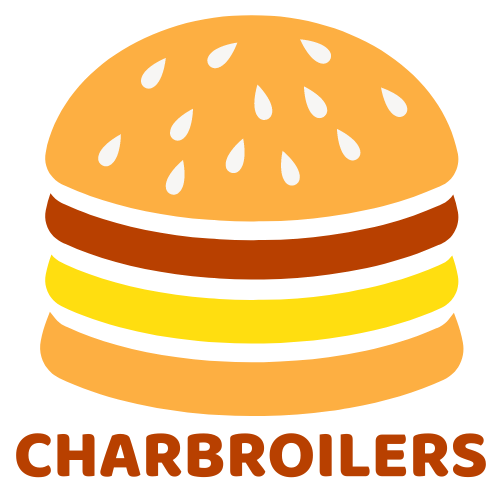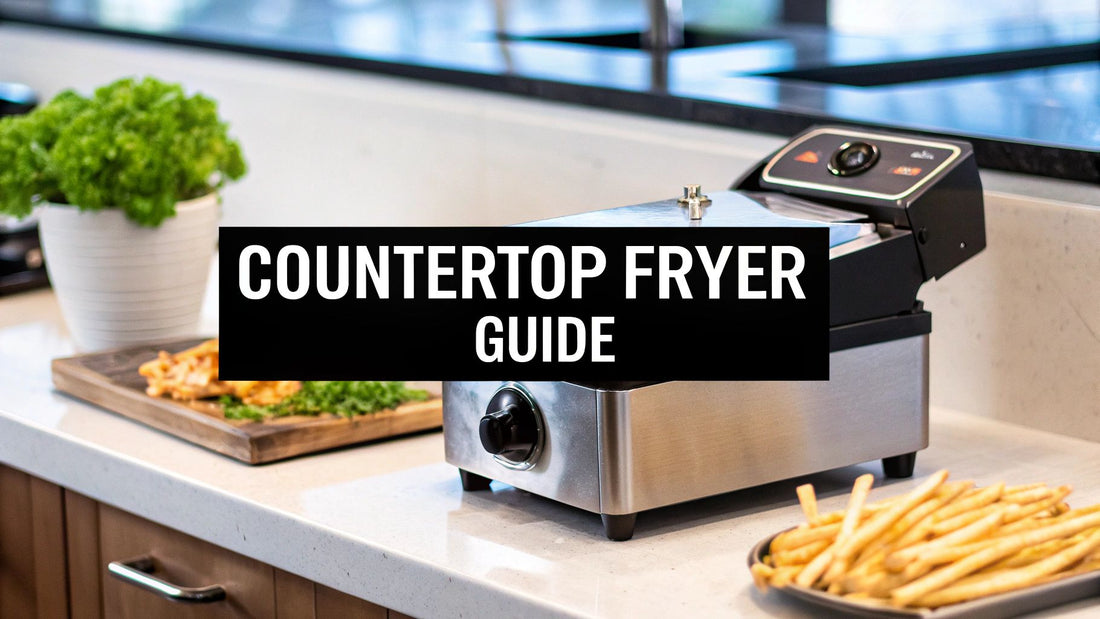
A Guide to Commercial Countertop Fryers
Share
At its core, a commercial countertop fryer is a compact, high-powered appliance that delivers professional-grade frying results without needing the massive footprint of a standard floor model. It's the perfect answer for kitchens tight on space, offering a ton of flexibility and efficiency to turn out consistently crispy, delicious food.
Why a Countertop Fryer Might Be Your Kitchen's MVP
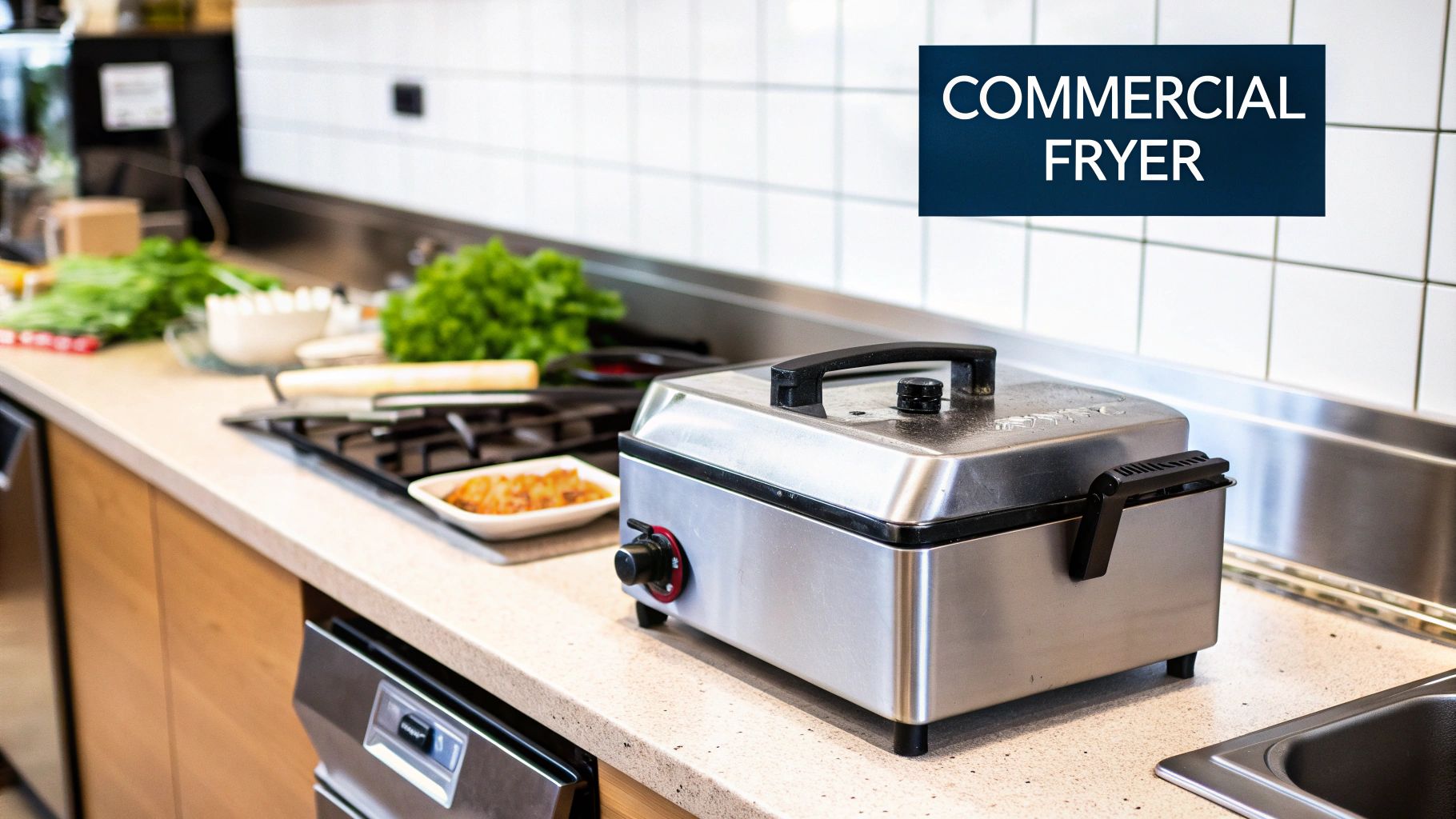
Don't think of a countertop fryer as just a smaller piece of equipment. Think of it as your kitchen's secret weapon. It’s a specialized tool that delivers perfect results while taking up minimal real estate, making it an absolute must-have in today's food service world, from busy restaurants to nimble food trucks.
This adaptability is a total game-changer. For a kitchen already packed to the gills, dropping in a countertop unit is way easier and more affordable than a major remodel to squeeze in a floor fryer. It’s a much smaller upfront investment, letting you expand your menu without a huge cash outlay.
The Power of Flexibility and Versatility
The real magic of a commercial countertop fryer is its operational flexibility. These units let you be more agile and react quickly to what your customers are craving. Instead of firing up a large, energy-guzzling floor model for a single, low-volume fried item, you can use a small, efficient countertop unit right where you need it.
This smart approach to equipment opens up some serious possibilities:
- Menu Expansion: Easily roll out new fried appetizers, side dishes, or even desserts like doughnuts and churros without messing up your existing kitchen rhythm.
- Preventing Flavor Transfer: Dedicate a specific countertop fryer to things like seafood or gluten-free options. This stops cross-contamination and keeps your flavors pure.
- Optimized Workflow: Place a fryer exactly where it makes the most sense, whether that's on the main line for hot-ticket items or in a prep station for appetizers.
This ability to add frying capacity precisely where it's needed most is why so many kitchens—from high-end restaurants to quick-service cafes—rely on these compact powerhouses. It’s about working smarter, not just harder.
The rising popularity of these fryers isn't a fluke; it points to a major industry trend. The commercial countertop fryer market is growing fast, fueled by the global demand for quick-service and fast-food. In 2024, the market was valued at approximately USD 1.2 billion and is expected to climb to around USD 1.8 billion by 2033. You can dig into the complete market analysis over at Verified Market Reports.
By bringing a commercial countertop fryer into your kitchen, you’re not just buying another appliance. You're investing in a tool that can streamline your entire operation, boost your bottom line, and unlock brand-new culinary opportunities.
Countertop Fryer Benefits at a Glance
To put it simply, these compact fryers punch well above their weight. Here's a quick breakdown of the advantages they bring to any professional kitchen.
| Feature | Primary Benefit | Ideal For |
|---|---|---|
| Small Footprint | Saves valuable counter and floor space. | Kitchens with limited space, food trucks, and concession stands. |
| Lower Initial Cost | More affordable than full-size floor models. | Startups, businesses on a budget, or those testing new menu items. |
| Menu Specialization | Prevents flavor transfer and cross-contamination. | Operations needing dedicated fryers for seafood, allergens, or desserts. |
| Workflow Efficiency | Can be placed exactly where needed for production. | Optimizing kitchen layouts and reducing staff movement during service. |
| Energy Savings | Uses less energy than a large, underutilized fryer. | Frying lower-volume items or operating during non-peak hours. |
Ultimately, adding a countertop fryer is a strategic move that delivers flexibility, efficiency, and a fantastic return on investment, no matter the size of your operation.
How a Commercial Fryer Actually Works
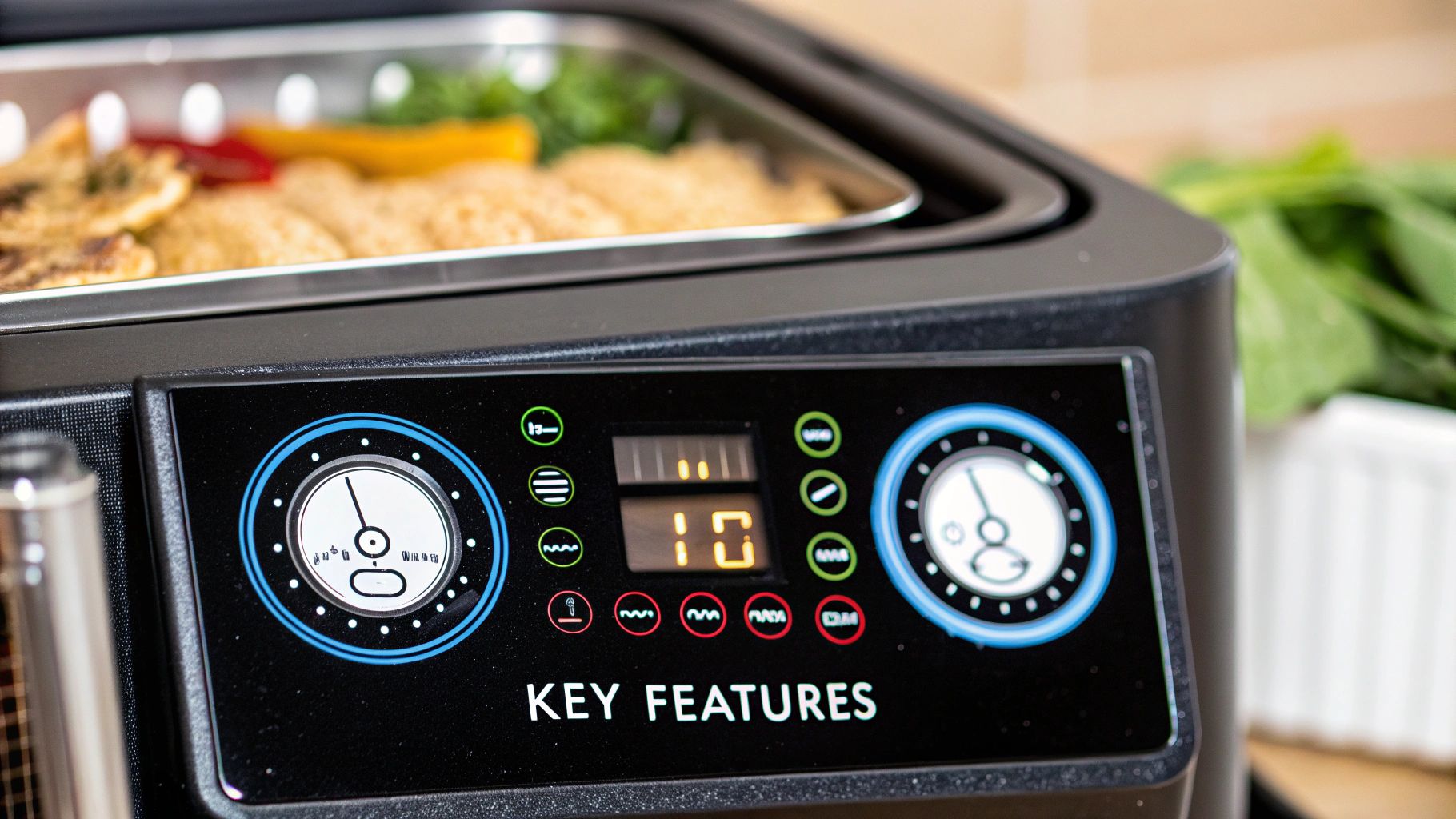
At first glance, a commercial fryer looks like a simple box filled with hot oil. But underneath that stainless steel exterior is a smart system, fine-tuned to do one thing exceptionally well: deliver perfectly fried food, batch after batch. To really get why one fryer outperforms another, we need to pop the hood and see what makes it all tick.
The heart of the whole operation is the fry pot—you’ll also hear it called the tank or vat. This is the container that holds all your cooking oil. It’s almost always made from heavy-duty stainless steel because it has to stand up to constant, screaming-hot temperatures and the daily abuse of a commercial kitchen. The size of the fry pot dictates your oil capacity, which in turn determines how much food you can pump out at once.
Of course, the oil doesn't heat itself. That’s the job of the heating element. In an electric fryer, you'll see a submerged metal coil, kind of like what's in an electric water heater. In a gas model, you’ll find powerful burners positioned right under the fry pot. This is the muscle, responsible for getting the oil up to temperature fast and keeping it there when things get busy.
The Brains of the Operation
The heating element is just brawn without a brain. That’s where the thermostat comes in. It’s the mission control for your fryer, constantly monitoring the oil's temperature. When you drop a basket of frozen onion rings into the oil, the temperature naturally plummets. The thermostat senses this instantly and tells the heating element to fire up and bring the heat back to your set point.
Think of it like the cruise control in your car. You set your speed (the temperature), and the system automatically hits the gas on an uphill climb (when you add cold food) and eases off on the downhill to maintain that perfect speed. This teamwork ensures your food comes out crispy and golden, not greasy and sad.
The Unsung Hero: The Cold Zone
Here’s a feature that separates the good fryers from the great ones: the cold zone. This is a small, brilliantly simple area at the very bottom of the fry pot, sitting just below the heating elements. Since heat rises, the oil in this little pocket stays much cooler than the rest of the cooking oil.
Why does that matter so much?
- It Makes Your Oil Last Longer: As you fry, little bits of breading and crumbs break off and sink. Without a cold zone, they would just sit in the hot oil, burning over and over. This scorching degrades your oil fast, making it dark and giving your food a nasty, bitter flavor.
- It Keeps Your Food Tasting Fresh: By falling into this cooler, calmer zone, those crumbs are taken out of the action. They don’t burn, which means they don’t foul up the oil. The result is cleaner oil for a longer time, and every batch of fries tastes as good as the first.
Once you understand this simple system—the pot, element, thermostat, and cold zone—you're no longer just looking at a metal box. You can see how the components work together to achieve perfection. It gives you the power to spot quality, troubleshoot problems, and ultimately make a much smarter buying decision for your kitchen.
Choosing Your Power Source: Gas vs. Electric Fryers
One of the first big decisions you'll make when picking a countertop fryer is the power source: gas or electric. This choice runs deeper than just what you plug in or hook up. It directly impacts your kitchen's speed, cooking precision, and even your monthly utility bills.
There's no single "best" answer here. The right fryer for you depends entirely on your menu, how busy you get, and the bones of your existing kitchen setup. It's a classic matchup of raw power versus pinpoint control.
The Case For Gas Countertop Fryers
For kitchens that are all about high volume and constant demand, gas fryers are the undisputed workhorses. Their defining feature? Raw power and speed.
Think of a gas fryer as the muscle car of your cooking line. It’s built for one thing: getting hot and staying hot.
- Rapid Heat-Up: Gas models fire up and heat oil much faster than their electric cousins. That means you're ready to start cooking sooner at the beginning of a shift.
- Quick Recovery Time: When you drop a basket of frozen fries into hot oil, the temperature naturally dips. Gas fryers are champions at "recovering" from that drop, getting the oil back to the perfect temperature in a flash. This is crucial for turning out crispy, not greasy, food during a dinner rush.
- Lower Utility Costs: In many places, natural gas is cheaper than electricity. For a busy kitchen, those savings can really add up on your monthly bills.
The trade-off? Gas fryers need a dedicated gas line and proper ventilation, which is often required by local safety codes. If that infrastructure isn't already in your kitchen, installation can get more complex and costly.
Key Takeaway: Gas countertop fryers are built for speed and endurance, making them the top choice for kitchens that prioritize high output and fast service. If you're running a busy line and every second counts, the rapid recovery time of a gas model is a major advantage.
This image gives you a clear snapshot of how countertop models compare to their larger, standard-sized siblings.
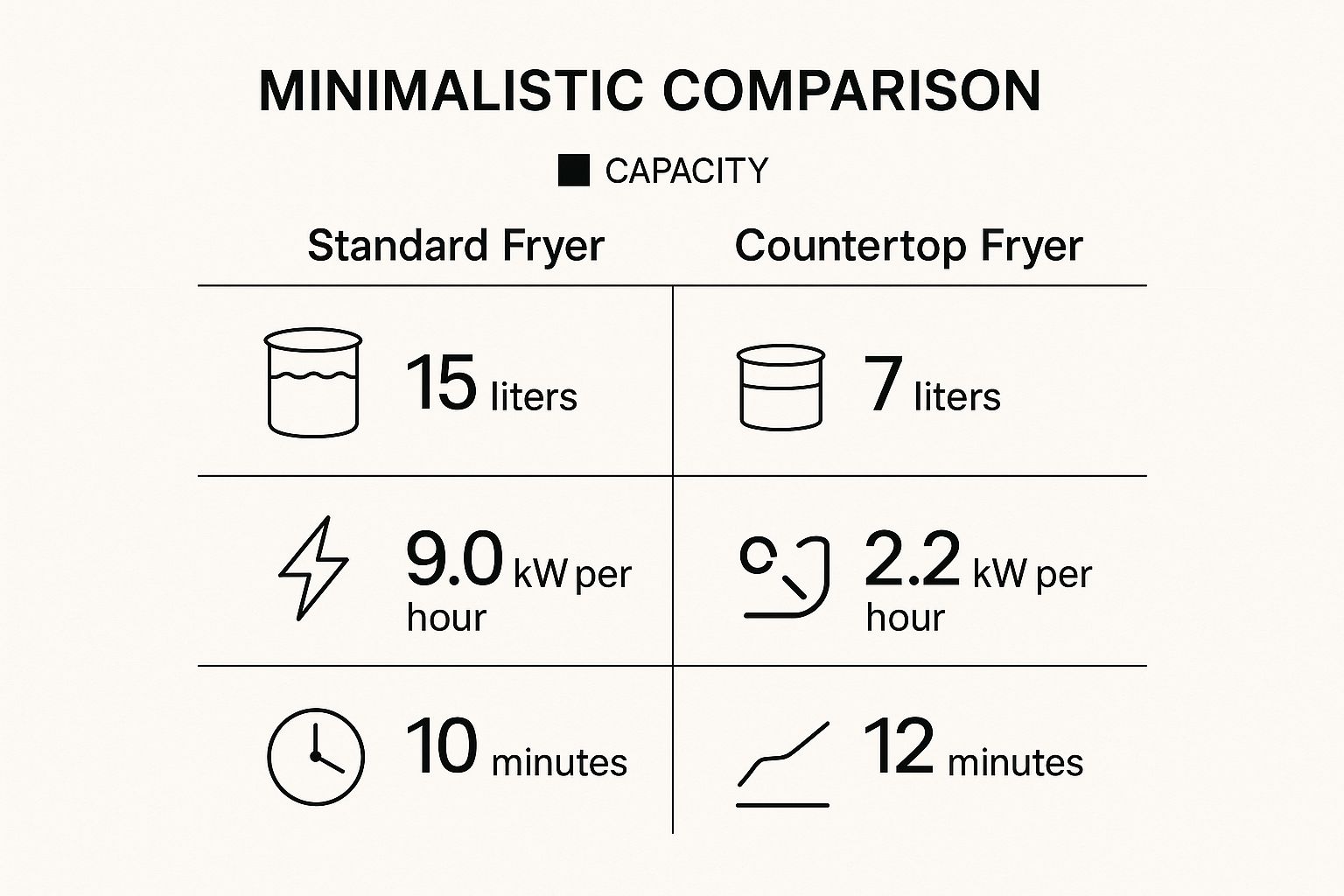
As you can see, while countertop units have a smaller footprint, they pack a punch with competitive cooking times and much lower energy use.
The Case For Electric Countertop Fryers
While gas models win on sheer power, electric fryers shine when it comes to precision and convenience. If a gas fryer is a muscle car, an electric model is a finely tuned sports car, celebrated for its exceptional temperature control.
The heating elements in an electric fryer provide a steadier, more consistent heat. This is a game-changer for delicate foods that demand a very specific frying temperature to come out right. Think tempura, doughnuts, or specialty pastries, where even a tiny temperature swing can ruin the final product.
And then there's the installation. It’s refreshingly simple: if you have a compatible electrical outlet, you're pretty much ready to go. This plug-and-play simplicity makes them perfect for food trucks, concession stands, or any kitchen where running a new gas line just isn't an option.
For businesses looking for that ultimate convenience and precision, you can find a wide range of top-tier commercial fryers that fit the bill.
Gas vs. Electric Countertop Fryer Showdown
So, how do you decide? This side-by-side comparison breaks down the key differences to help you figure out which power source best fits your kitchen's needs.
| Consideration | Gas Fryer | Electric Fryer |
|---|---|---|
| Heat-Up & Recovery | Very Fast. Excellent for high-volume rushes. | Slower. More gradual heat-up and recovery. |
| Temperature Control | Good. Can have minor fluctuations. | Excellent. Provides steady, precise heat. |
| Best For | High-volume items like fries, onion rings, chicken. | Delicate items like tempura, doughnuts, pastries. |
| Installation | Complex. Requires a gas line and professional setup. | Simple. Plugs into a compatible electrical outlet. |
| Portability | Low. Tied to the gas line connection. | High. Easy to move as needed. |
| Operating Cost | Generally Lower. Natural gas is often cheaper. | Generally Higher. Electricity can be more expensive. |
| Kitchen Impact | Higher. Produces more ambient heat. | Lower. More efficient, less waste heat. |
Ultimately, the choice comes down to your priorities. If you're frying hundreds of pounds of fries a day, the speed and low operating cost of a gas fryer are tough to beat. But if your menu features delicate, temperature-sensitive items, the precision of an electric model will give you the consistency you need to produce a perfect product every time.
Matching a Fryer to Your Business Needs
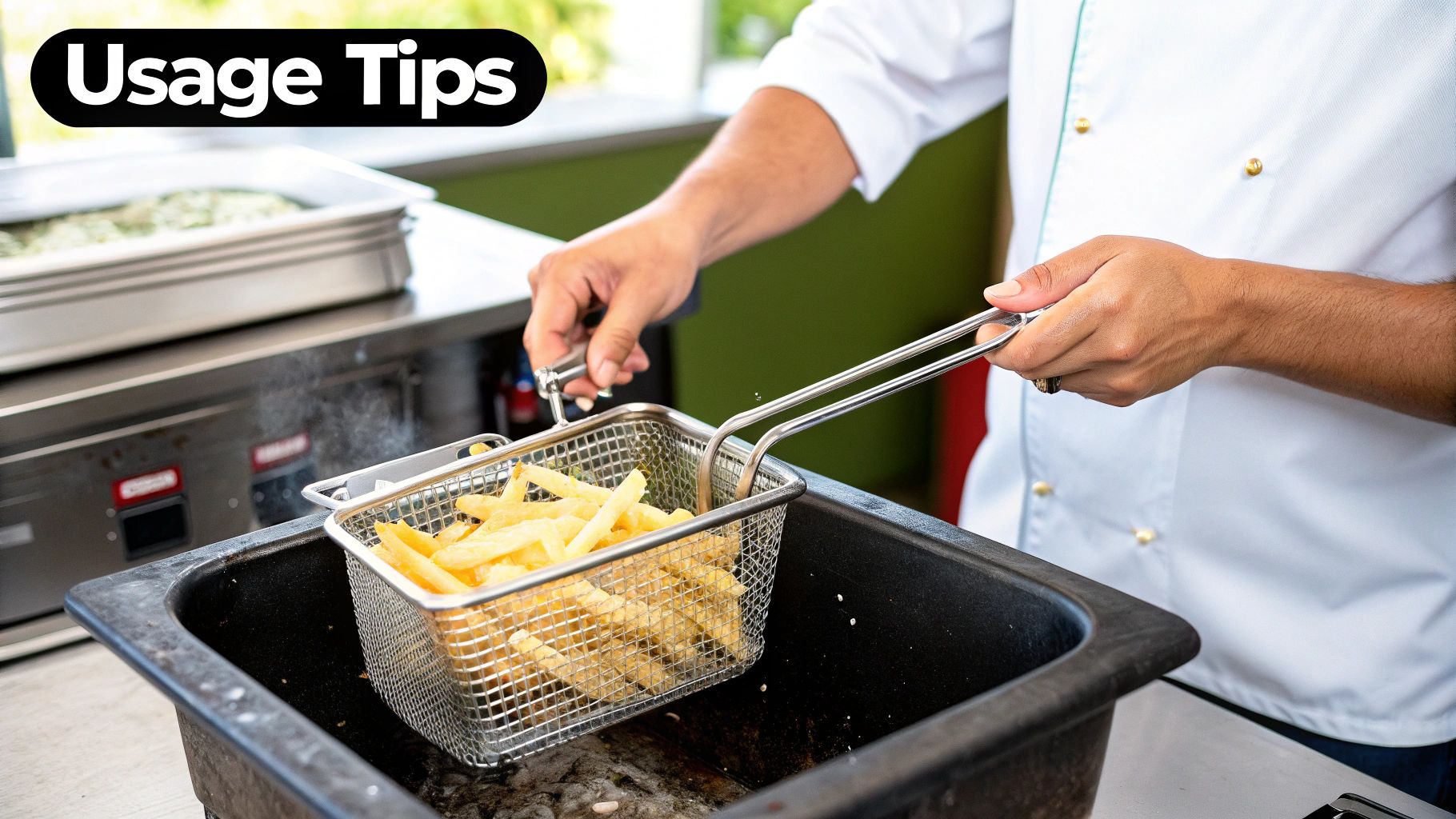
Alright, you've figured out whether gas or electric is your best bet. Now comes the fun part: digging into the specs that really determine how a commercial countertop fryer will perform in the heat of battle. This is where we move past the basics and start matching the machine's capabilities to your menu, your volume, and your kitchen's unique rhythm.
Choosing the right fryer isn't about finding the "best" one on the market. It's about finding the perfect fit for what you do every day. A fryer that’s a dream for a high-volume French fry station could be total overkill for a café that only occasionally fries up some appetizers.
Let's break down the key factors that translate those technical numbers into real-world kitchen performance.
Sizing Up Your Fry Pot Capacity
First up, and arguably the most important number to look at, is the fry pot capacity. It's usually measured in pounds of oil, and this single spec dictates your maximum output. A small 15-pound capacity fryer, for instance, is perfect for lower-volume tasks or for a dedicated, specific job like frying gluten-free items to prevent cross-contamination.
On the flip side, a bigger 30-pound or 40-pound capacity model is built for the chaos of a dinner rush, letting you drop multiple baskets at once. Think about your busiest hour—how many orders of fried food are you pumping out? Your answer to that question points you directly to the oil capacity you need.
The goal isn't just to get the biggest pot you can find. It's to find the right size. An oversized, underused fryer is a waste of oil and energy. But an undersized one will create a bottleneck that slows down your entire kitchen when you can least afford it.
Understanding Recovery Time
Tied directly to capacity is recovery time. This is the critical window it takes for your oil to get back to its ideal cooking temperature after you've dropped in a basket of cold or frozen food. A fast recovery time is the secret ingredient to consistently crispy, golden-brown food instead of a soggy, oil-logged mess.
It's simple, really: fryers with higher power ratings—more BTUs for gas, more Watts for electric—generally bounce back faster. If your kitchen needs to crank out back-to-back batches of wings or fries without skipping a beat, a fast recovery time is an absolute must-have.
Physical Footprint and Material Durability
Let's be practical. A countertop fryer has to earn its real estate. Before you click "buy," get out the tape measure. You need to know your available counter space and make sure there’s enough clearance around the unit for safe operation and proper ventilation. The physical footprint is a hard limit you just can't fudge.
Beyond its size, look at what it's made of. A durable, heavy-duty stainless steel body is the industry standard for a reason. It stands up to the heat, resists rust, and handles the daily abuse of a commercial kitchen while being far easier to clean. Smooth, welded seams are a big plus, too, since they leave nowhere for grease and grime to hide.
- Single vs. Double Tank: Do you need to fry fish and fries at the same time without the flavors mingling? A double-tank fryer with separate controls is your answer.
- Ease of Cleaning: Look for models with removable heating elements and oil tanks. Small features like a front-facing drain valve make the dreaded task of emptying old oil much simpler and safer for your staff.
By carefully thinking through these practical specs, you can cut through the marketing noise and find a fryer that becomes a genuine workhorse for your kitchen. For more detailed comparisons, be sure to check out our complete guide to the top commercial deep fryers reviewed, which can help you narrow down your choices even further.
Installation and Maintenance Best Practices
Your shiny new countertop fryer is more than just another piece of equipment—it's a serious investment in your kitchen’s output and your menu’s reputation. To make that investment pay off, you need a smart plan for installation and upkeep. This isn't about adding a bunch of tedious chores to your staff's to-do list. It's about building simple, solid habits that keep everyone safe, make the fryer last for years, and ensure every single dish comes out perfectly golden and delicious.
Proper installation is the first step, and it's non-negotiable. Always, always place your fryer on a stable, level surface that won’t catch fire. You’ll need to check your local fire and health codes, as most places have strict rules about where you can put it, how much clearance you need from other gear, and what kind of fire suppression systems are required. Giving the unit enough breathing room isn't just a safety thing—it also allows for proper airflow, helping the fryer run efficiently without overheating.
Creating a Routine for Success
The real secret to a long-lasting, high-performing fryer isn't a secret at all: it's consistency. A simple, structured cleaning and maintenance schedule can head off the vast majority of equipment headaches before they start. When you break the tasks down into daily, weekly, and monthly duties, the whole process becomes manageable and way less of a drag for your kitchen crew.
And let's be honest, a well-maintained fryer doesn't just last longer—it makes better-tasting food. Old, neglected oil and a layer of built-up grime will impart bitter, burnt flavors that can ruin even the best ingredients.
Key Insight: Think of fryer maintenance as a core part of your recipe. Clean equipment and fresh oil are just as important as the food you put into it. A disciplined approach ensures food safety, operational efficiency, and consistent quality that customers will notice.
The Daily, Weekly, and Monthly Breakdown
A structured cleaning schedule takes the guesswork out of the equation and makes sure critical tasks never get skipped. Here’s a simple framework you can build on, adjusting it based on how busy your kitchen gets.
Daily Tasks (End of Day)
- Wipe Down Exterior: Grab a food-safe degreaser and clean all the outside surfaces. This prevents that sticky, greasy film from building up.
- Clean Fry Baskets: After service, give the fry baskets a thorough scrub to get rid of every last food particle and bit of residue.
- Filter the Oil: If your fryer has a built-in filtration system, run it daily. If not, carefully filter the oil through a cone filter into a clean, safe container. This one step can dramatically extend the life of your oil, saving you real money.
Weekly Tasks
- Perform a Boil Out: This is the deep clean for your fry pot. After you’ve drained the old oil, fill the pot with water and a specialized fryer-cleaning solution. Bring it to a slow boil for about 20 minutes. This process strips away the tough, carbonized gunk that daily wiping just can’t touch.
- Inspect Components: Take a close look at the heating elements, thermostats, and drain valves. You’re looking for any signs of wear, damage, or anything that just doesn't seem right. Catching small issues early prevents costly repairs down the road.
Monthly Tasks
- Calibrate the Thermostat: Use a good kitchen thermometer to check if your fryer's temperature display is accurate. A thermostat that’s off can lead to greasy, undercooked food or, worse, a serious safety risk.
- Thorough Inspection: Give the entire unit a top-to-bottom check. That includes power cords and gas connections (if you have a gas model).
The demand for reliable equipment like this is clear. The global market for commercial deep fryers is on the rise, pushed by the growth of restaurants and fast-food spots. This trend, highlighted in this commercial deep fryer market report, just goes to show how vital these tools are—and why keeping them in top shape is so important. And just as you'd maintain a fryer, keeping other key equipment running smoothly is also critical; you can check out our guide on cooking up success with commercial hot plates for more expert tips.
Complete Your Kitchen with a Commercial Charbroiler
A top-notch commercial countertop fryer is your ticket to golden-brown appetizers and sides, but that's only half the story. If you want true menu versatility, you need to think beyond the fryer basket. The real magic—the kind that produces a perfect sear, unforgettable grill marks, and that smoky flavor customers line up for—comes from a commercial charbroiler.
Pairing your fryer with the right charbroiler opens up a completely new playbook for your kitchen. Just like you picked a fryer based on your specific needs, choosing a charbroiler means understanding the different ways they bring the heat. Let's break down the most popular types so you can find the perfect partner for your fryer, whether you're grilling delicate fish or hefty ribeyes.
Infrared Charbroilers for Flawless Searing
For kitchens that simply can't compromise on intense, even heat, an infrared charbroiler is a total game-changer. These units use special ceramic or metal plates that radiate heat directly and evenly onto your food.
Think of it like using a magnifying glass to focus sunlight. Instead of just bathing the food in hot air, infrared technology shoots powerful, uniform heat right at the surface. This creates an immediate sear that locks in every drop of juice and flavor.
- Exceptional Heat: Infrared gets hotter and stays hotter, meaning you get much faster cook times.
- Perfectly Even Cooking: Forget about hot spots. The radiant heat ensures every inch of that burger or steak cooks at the same rate.
- Reduced Flare-Ups: Drippings vaporize instantly on the super-hot plates, so you get fewer flare-ups, less unwanted char, and more control.
This kind of precision makes infrared models the go-to for high-end steakhouses and any spot that stakes its reputation on perfectly cooked proteins.
Gas Charbroilers for Authentic Smoky Flavor
When your guests are craving that classic, backyard-barbecue taste, nothing delivers like a gas charbroiler. These workhorses use powerful burners to heat up radiant elements or lava rocks, which cook the food while creating that iconic smoky flavor.
The real magic kicks in when drippings hit those hot radiants or rocks. They instantly turn to smoke, which swirls around the food and infuses it with a depth of flavor you just can't fake. For any restaurant aiming to serve up an authentic, flame-grilled experience, a gas model is the undisputed champ.
The Takeaway: While a commercial countertop fryer nails your crispy classics, a charbroiler is what lets you expand into grilled entrees. Whether you go with infrared, gas, or electric all comes down to your menu, your space, and the flavor profile you're chasing.
Electric Charbroilers for Precision and Simplicity
What if a gas line just isn't in the cards? Or maybe you just want dead-simple operation and rock-solid temperature control. In that case, an electric charbroiler is a fantastic choice. These units offer plug-and-play simplicity that’s perfect for food trucks, concession stands, or smaller cafes.
While they won’t produce the same heavy smoke flavor as their gas-powered cousins, they absolutely excel at delivering steady, reliable heat. This makes them ideal for more delicate items like grilled vegetables or seafood, where precise temperature management is everything.
By adding the right charbroiler to your line, you’re not just finishing a cook station—you’re turning your kitchen into a destination for grilled perfection.
Frequently Asked Questions
Digging into commercial kitchen equipment can unearth a lot of questions. And when it’s something as essential as a commercial countertop fryer, getting straight answers is the only way to make smart buys, solve problems on the fly, and keep your kitchen humming. This section tackles the most common questions I hear from chefs and kitchen managers just like you.
How Often Should I Filter or Change Fryer Oil?
There’s no magic number here—how often you change your fryer oil really comes down to what you're cooking and how much you're cranking out. But there are some solid rules of thumb to live by.
For lighter-duty work, like frying vegetables or items without a lot of breading, you can usually get away with filtering the oil daily and doing a complete change-out once a week. This keeps things clean and your food tasting fresh.
But if you're running a high-volume kitchen or frying heavily breaded items like fried chicken or fish, the game changes. Those breading particles break down in the oil much faster. In that kind of environment, you’ll likely need to filter the oil after every big rush and swap it out completely every 2-3 days.
The best advice I can give? Trust your senses. If the oil gets dark, smells off, or starts smoking at a lower temperature than it should, it's time for a change. Think of high-quality oil as a direct investment in high-quality food.
Are Countertop Fryers a Good Choice for Food Trucks?
Yes, absolutely. In fact, commercial countertop fryers almost feel like they were designed specifically for the tight quarters of a food truck kitchen. Their biggest win is the space-saving design, letting you pack some serious frying power into a tiny footprint.
You’ve got great options with both electric and propane-powered gas models, depending on your truck's power setup and what’s on your menu. Electric fryers offer that simple plug-and-play convenience, while propane units bring massive power and quick recovery times—perfect for handling those long lines at a festival or the lunch rush.
The most important thing for any food truck is nailing safety and compliance. You absolutely must make sure your mobile kitchen meets all local health and fire safety rules. This almost always means having a professional-grade ventilation system and an approved fire suppression system installed right over your cooking gear.
What Is Recovery Time and Why Does It Matter?
Recovery time is easily one of the most critical performance stats for any commercial fryer. It’s all about how quickly the cooking oil bounces back to its target temperature after you’ve dropped in a basket of cold or frozen food.
Think about it: when you dunk a basket of frozen fries into 350°F oil, the oil’s temperature plummets. A slow recovery means your food is just sitting in lukewarm oil, soaking up grease. The result? Soggy, unappetizing food.
A fast recovery time is make-or-break for a few key reasons:
- It Makes Food Crispy: Bringing the oil back to the right temp quickly sears the outside of the food, locking out excess oil.
- It Boosts Throughput: Faster recovery lets you cook batches back-to-back without waiting, which is vital for serving customers efficiently during peak hours.
- It Guarantees Consistency: It ensures the last batch of the night is just as perfectly cooked as the first.
As a general rule, fryers with more power—measured in BTUs (British Thermal Units) for gas models and Watts for electric—are going to have a faster recovery time.
Should I Get a Single Pot or a Double Pot Fryer?
Choosing between a single-pot and a double-pot fryer really boils down to your menu and how you need to manage your workflow. Each one serves a very different purpose in a pro kitchen.
A single-pot fryer is your workhorse for pumping out high volumes of one specific thing. If your restaurant is famous for its french fries and you’re selling hundreds of orders a day, a big, single-tank unit is the most efficient tool you can have.
A double-pot fryer, on the other hand, gives you two smaller, independent tanks, each with its own heat source and thermostat. This setup is a lifesaver when you need to stop flavor transfer between different foods. For instance, you could fry breaded fish in one tank and delicate, gluten-free onion rings in the other without any flavor crossover.
The versatility of a double-pot fryer also means you can cook two different items at two different temperatures at the same time, giving your kitchen a whole new level of flexibility. It’s the perfect answer for a more diverse menu.
Ready to round out your kitchen’s cooking line? We offer a wide selection of commercial charbroilers for your restaurant, including infrared, gas, and electric charbroilers. A great fryer is essential, but a charbroiler will help you serve up that unforgettable grilled flavor. Visit us at https://charbroilers.com.
